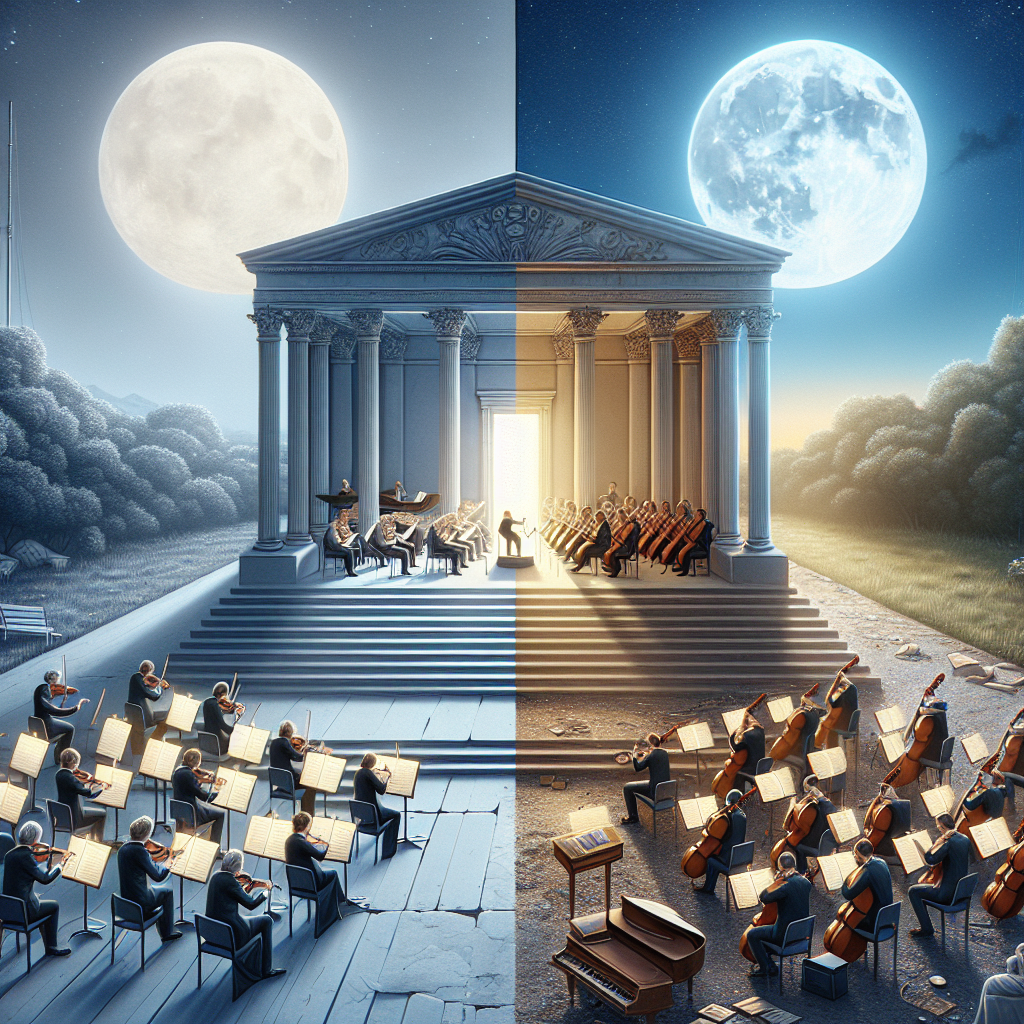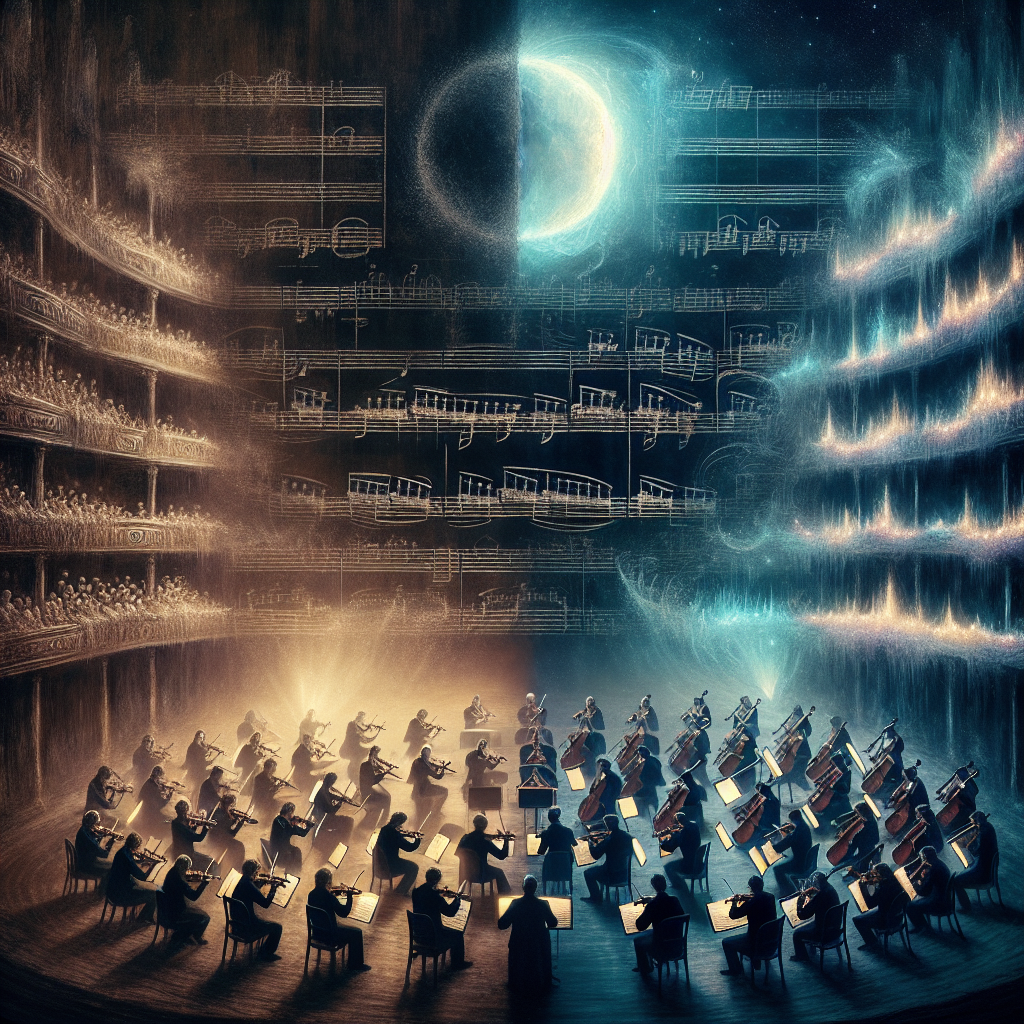
The ‘Moonlight’ Sonata – Romanticism vs. Classical Structure
Ludwig van Beethoven, an iconic figure in Western classical music, has left an indelible mark with his prodigious output. Among his various compositions, Beethoven’s piano sonatas, particularly the “Moonlight” Sonata, stand out for their emotional depth and structural ingenuity. The “Moonlight” Sonata, officially known as Piano Sonata No. 14 in C-sharp minor “Quasi una fantasia,” Op. 27, No. 2, epitomizes the transitional phase from Classical to Romantic era in music, embodying the quintessential elements of each period.
Written in 1801 and dedicated to Countess Giulietta Guicciardi, the “Moonlight” Sonata remains one of Beethoven’s most beloved works. Its nickname “Moonlight” was not given by Beethoven but by the music critic Ludwig Rellstab, who remarked that the first movement reminded him of moonlight shining on Lake Lucerne. This evocative imagery has stuck through the ages, adding a layer of popular mythology to the sonata. Beethoven’s compositional genius and complex personal history, coupled with the accessible emotional depth of his work, have cemented his place as one of the greatest composers of all time.
Beethoven composed the “Moonlight” Sonata during a period of personal turmoil, grappling with the encroaching silence brought about by his worsening deafness. This sorrowful acceptance of fate, and determination to continue composing despite his ailments, resonates through the sonata’s melancholic yet hopeful tones. The “Moonlight” Sonata is part of Beethoven’s middle period, transitioning from the influence of his Classical predecessors like Haydn and Mozart towards the more emotionally driven Romantic style.
Through an exploration of the “Moonlight” Sonata’s three movements, one can appreciate Beethoven’s intricate balancing act between Romantic expression and Classical structure. This essay aims to dissect these elements within the sonata, shedding light on how Beethoven navigated these dual influences and forged new paths within the piano sonata genre.
First Movement: Adagio sostenuto
The first movement of the “Moonlight” Sonata, “Adagio sostenuto,” is arguably its most famous part. Composed in C-sharp minor, it opens with a hauntingly beautiful melody that floats above a triplet accompaniment, creating an almost otherworldly atmosphere. This movement deviates from the typical sonata-allegro form, opting instead for a ternary structure that evokes a seamless, introspective quality. The left-hand triplets, along with the right-hand melody, evoke a sense of delicate melancholy and introspection.
Beethoven’s use of dynamic markings is minimal, allowing for personal interpretation and emotional expression by the performer. The subtlety and restraint required to play this movement effectively demonstrate the blending of stringent Classical form with the burgeoning expressiveness of the Romantic era. The introspective quality of the first movement contrasts with the more vigorous and complex nature of the following movements, setting the stage for a journey through varying emotional landscapes.
The emotional impact of the “Adagio sostenuto” cannot be overstated. It has become emblematic of Beethoven’s ability to convey deep emotion with minimalistic means, proving that powerful music doesn’t necessarily require complex textures or fast tempos. This movement’s blend of simplicity and profound emotion has ensured its enduring popularity and has contributed to the mythos surrounding Beethoven’s genius.
In essence, the first movement of the “Moonlight” Sonata exemplifies the Romantic spirit’s focus on emotional expression while still adhering to a Classical structure. It represents a bridge between two styles, demonstrating Beethoven’s ability to innovate within established forms.
Second Movement: Allegretto
The second movement, “Allegretto,” provides a stark contrast to the somber opening movement. Set in D-flat major, it offers a respite with its light-hearted, almost dance-like quality. This movement is structured as a simple scherzo and trio, a common feature in Classical sonatas, showcasing Beethoven’s adherence to traditional forms even as he pushed their boundaries.
The “Allegretto” features a delicate interplay between the hands, with a lilting melody that dances above a steady accompaniment. The trio section introduces a minor key, adding a hint of complexity and tension before returning to the cheerful scherzo theme. This interplay between light and shadow, major and minor, reflects Beethoven’s mastery in creating musical narrative and emotional contrast.
The second movement demonstrates Beethoven’s skillful use of thematic development and variation, a hallmark of Classical composition. However, the emotional nuances and the expressive use of dynamics give it a Romantic character. The cheerfulness of this movement, juxtaposed with the gravity of the first and third movements, exemplifies Beethoven’s ability to create a cohesive work that takes the listener through a wide range of emotions.
Ultimately, the “Allegretto” serves as a bridge between the introspective first movement and the turbulent finale, showcasing Beethoven’s ability to balance structure with expressiveness. It is a testament to his ingenuity in weaving together elements of Classical clarity and Romantic emotion within a single composition.

Third Movement: Presto agitato
The final movement, “Presto agitato,” is the climax of the “Moonlight” Sonata, characterized by its relentless drive and intensity. In C-sharp minor, it returns to the somber tonality of the first movement but with a dramatically different energy. The “Presto agitato” follows the sonata-allegro form, adhering to Classical conventions while unleashing the full force of Romantic expression.
This movement is marked by its technical demands, with rapid arpeggios and scales that require a high level of virtuosity. The dynamic contrasts and dramatic shifts in tempo create a sense of urgency and unrest, reflecting Beethoven’s personal struggles and the tumultuous spirit of the Romantic era. The “Presto agitato” is a tour de force of pianistic technique and emotional intensity, showcasing Beethoven’s ability to push the boundaries of the piano’s expressive capabilities.
The structure of this movement is meticulously crafted, with a clear exposition, development, and recapitulation. Yet, within this Classical framework, Beethoven infuses a sense of spontaneity and emotional volatility, embodying the Romantic ideal of music as a direct expression of the composer’s inner world. The rapid passages and abrupt dynamic changes demand both technical precision and emotional depth from the performer.
In conclusion, the “Presto agitato” is a fitting conclusion to the “Moonlight” Sonata, encapsulating the dualities that define Beethoven’s work: structure and freedom, clarity and complexity, order and chaos. It is a powerful testament to Beethoven’s legacy and his role in bridging the Classical and Romantic eras.
Conclusion
The “Moonlight” Sonata remains one of Beethoven’s most iconic and beloved works, a testament to his genius and his ability to transcend the confines of musical forms. Through its three movements, the sonata encapsulates the essence of the transitional period between Classical restraint and Romantic expressiveness. Each movement, from the hauntingly beautiful “Adagio sostenuto” to the light-hearted “Allegretto” and the tumultuous “Presto agitato,” offers a unique glimpse into Beethoven’s musical mind.
Beethoven’s piano sonatas, and the “Moonlight” Sonata in particular, showcase his innovative spirit and his ability to infuse deep emotion into structured forms. This balance between Classical precision and Romantic depth is what makes the “Moonlight” Sonata a perennial favorite among both musicians and audiences. It is a work that continues to captivate and move listeners, more than two centuries after its composition.
The enduring popularity of the “Moonlight” Sonata is a testament to Beethoven’s timeless appeal and his unparalleled ability to communicate through music. It is a masterpiece that transcends the boundaries of time and style, embodying the universal human experience of sorrow, joy, conflict, and resolution.
In studying the “Moonlight” Sonata, we not only gain insight into Beethoven’s compositional techniques but also a deeper understanding of the emotional and cultural currents of his time. It remains a powerful example of how music can convey complex emotions and ideas, bridging the gap between composer and listener. Beethoven’s legacy lives on through works like the “Moonlight” Sonata, which continue to inspire and resonate with people around the world.